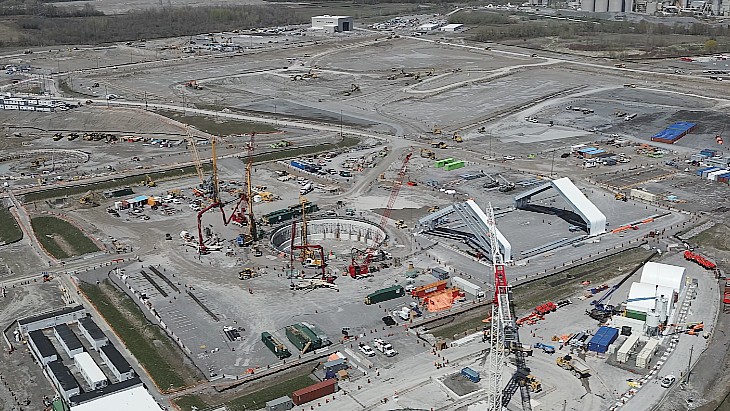Work starts on first phase of Myrrha
.jpg)
Myrrha - Multipurpose Hybrid Research Reactor for High-tech Applications - will be a sub-critical assembly relying on accelerated protons producing neutrons in the target to achieve periods of criticality in a low-enriched uranium core. It will be a 57 MWt accelerator-driven system in which a proton accelerator will deliver a 600 MeV proton beam to a liquid lead-bismuth (Pb-Bi) spallation target that is in turn coupled to a Pb-Bi cooled subcritical fast nuclear core.
Myrrha will be built in three phases. Phase 1 will be the creation of Minerva, which consists of the particle accelerator and two target facilities. In phase 2, the particle accelerator will be expanded to 600 MeV to increase the fundamental physics portfolio and expand it with radioactive isotope beam facilities. In phase 3, the nuclear reactor itself will be built. The project should be fully operational from 2038.
It is intended to replace Belgium's ageing BR2 research reactor, and will be used in a range of research functions including the demonstration of the concept of transmutation of long-lived radionuclides in nuclear waste, as well as producing radioisotopes for medicine. Myrrha will also be used for conducting fundamental scientific research in areas such as nuclear physics, atomic physics, fundamental interactions, solid-state physics and nuclear medicine.
In 2010, the Belgian government gave the go-ahead for the construction of Myrrha. The country is to contribute 40% towards the EUR1.6 billion investment the project will require. The Myrrha project is envisaged as a partnership of Belgium, the European Union, the European Investment Bank and other partners, with 70% of the funding from EU countries.
Belgium's Council of Ministers approved EUR558 million (USD646 million) in funding for Myrrha in September 2018. The funding will be provided over the period 2019-2038, firstly to cover by 2026 both the investments of the Minerva installation, the studies and the development of the installation, and secondly the operating costs of the Minerva installation after 2027.
In a ceremony held on 25 June, Belgium's Minister of Energy Tinne Van der Straeten gave the starting signal for the groundbreaking ceremony at the Minerva construction site at the Belgian Nuclear Research Centre's (SCK-CEN's) site in Mol.
In addition to researching new materials for advanced reactors, fundamental research and accelerator technology improvement, Minerva will be used specifically for medical purposes. It will be producing a new generation of medical radioisotopes that emit alpha particles which only attack a cancer patient's tumor, leaving the healthy tissue intact. This allows cancer treatment that is far less invasive for the patient.
"Thanks to renowned institutions such as SCK-CEN and IRE [Belgium's National Institute of Radioelements], Belgium has been able to establish a solid tradition in terms of medical radioisotopes and cutting-edge research," Van der Straeten said. "The launch of Minerva is a milestone in Belgium's nuclear research and opens a new chapter in our tradition of excellent nuclear research and medical radioisotope production, ultimately ensuring the continuity of radioisotope production activities and preserving jobs in the Kempen region."
The Myrrha project forms part of the European Strategy Forum on Research Infrastructures, and is one of three new research reactors forming the cornerstones of the European Research Area of Experimental Reactors, alongside the Jules Horowitz Reactor at Cadarache in France and the Pallas reactor at Petten in the Netherlands.
Hamid Aït Abderrahim, director of the Myrrha programme and deputy director general of SCK-CEN, said: "Myrrha may enable us to reuse some of the high-level nuclear waste from our current nuclear power plants, which remains radiotoxic for up to 300,000 years, as fuel. Our research shows that we can return nuclear waste to its natural radiotoxicity levels after only 300 years. This would allow us to reduce the problem of nuclear waste from a geological timescale to a human timescale.
"We can also reduce volumes by a factor of 100. After 40 years of nuclear power plant operations, Belgium's high-level nuclear waste covers the surface area of a football pitch at 0.5 metre high. With the technology we are researching with Myrrha, we can reduce that height to 5 millimetres. This makes Myrrha an interesting European research project that can help to optimise the nuclear waste problem of our current reactors. However, today we are here for Minerva's beginning."
_92619.jpg)

_84504.jpg)








